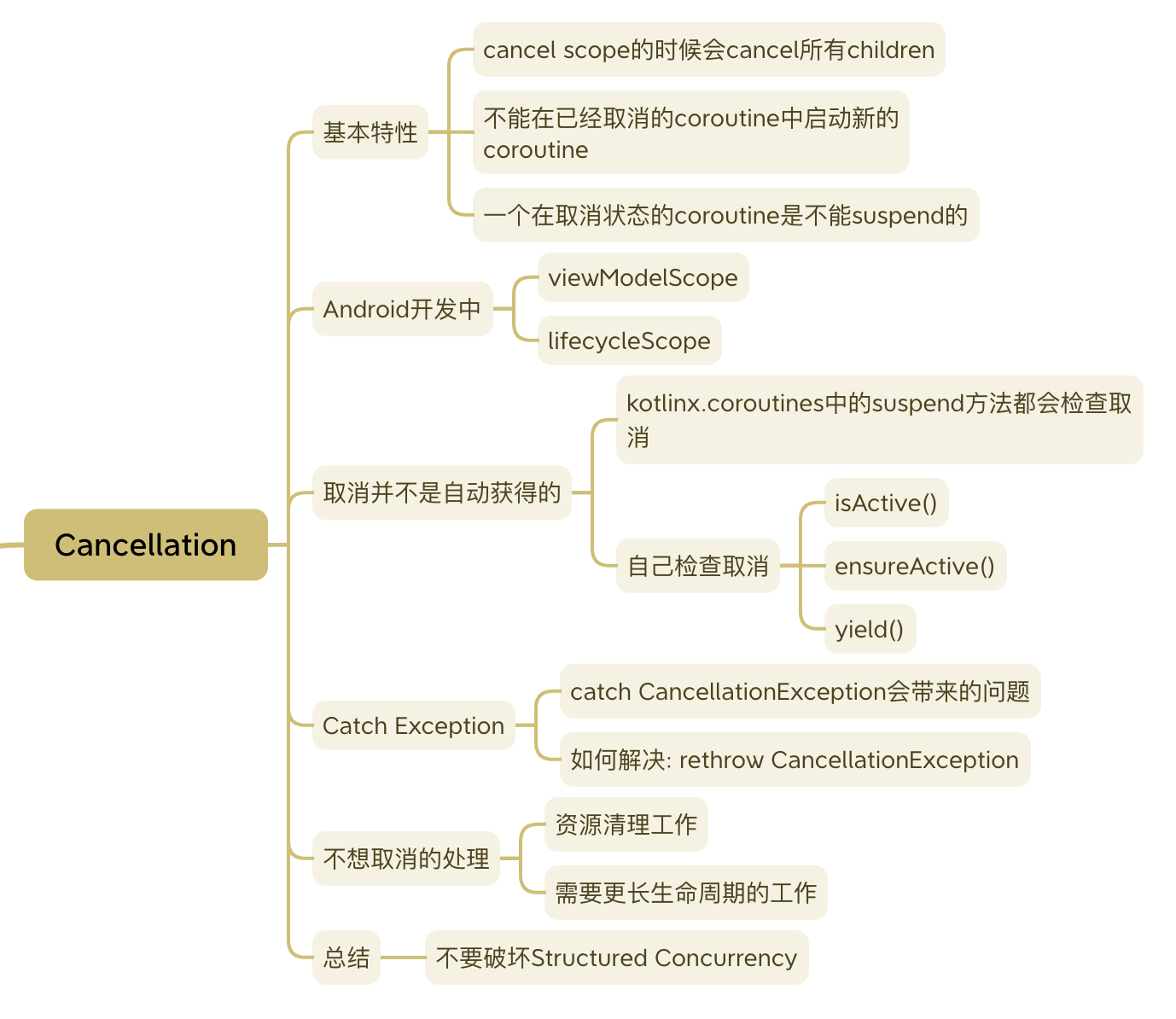[Kotlin Tutorials 21] 协程的取消
协程的取消
本文讨论协程的取消, 以及实现时可能会碰到的几个问题.

本文属于合辑: https://github.com/mengdd/KotlinTutorials
协程的取消
取消的意义: 避免资源浪费, 以及多余操作带来的问题.
基本特性:
- cancel scope的时候会cancel其中的所有child coroutines.
- 一旦取消一个scope, 你将不能再在其中launch新的coroutine.
- 一个在取消状态的coroutine是不能suspend的.
如果一个coroutine抛出了异常, 它将会把这个exception向上抛给它的parent, 它的parent会做以下三件事情:
- 取消其他所有的children.
- 取消自己.
- 把exception继续向上传递.
Android开发中的取消
在Android开发中, 比较常见的情形是由于View生命周期的终止, 我们需要取消一些操作.
通常我们不需要手动调用cancel()方法, 那是因为我们利用了一些更高级的包装方法, 比如:
viewModelScope: 会在ViewModel onClear的时候cancel.lifecycleScope: 会在作为Lifecycle Owner的View对象: Activity, Fragment到达DESTROYED状态时cancel.
取消并不是自动获得的
all suspend functions from kotlinx.coroutines are cancellable, but not yours.
kotlin官方提供的suspend方法都会有cancel的处理, 但是我们自己写的suspend方法就需要自己留意.
尤其是耗时或者带循环的地方, 通常需要自己加入检查, 否则即便调用了cancel, 代码也继续在执行.
有这么几种方法:
isActive()ensureActive()yield(): 除了ensureActive以外, 会出让资源, 比如其他工作不需要再往线程池里加线程.
一个在循环中检查coroutine是否依然活跃的例子:
fun main() = runBlocking { val startTime = currentTimeMillis() val job = launch(Dispatchers.Default) { var nextPrintTime = startTime var i = 0 while (isActive) { // cancellable computation loop // print a message twice a second if (currentTimeMillis() >= nextPrintTime) { println("job: I'm sleeping ${i++} ...") nextPrintTime += 500L } } } delay(1300L) // delay a bit println("main: I'm tired of waiting!") job.cancelAndJoin() // cancels the job and waits for its completion println("main: Now I can quit.") }
输出:
job: I'm sleeping 0 ... job: I'm sleeping 1 ... job: I'm sleeping 2 ... main: I'm tired of waiting! main: Now I can quit.
catch Exception和runCatching
众所周知catch一个很general的Exception类型可能不是一个好做法.
因为你以为捕获了A, B, C异常, 结果实际上还有D, E, F.
捕获具体的异常类型, 在开发阶段的快速失败会帮助我们更早定位和解决问题.
协程还推出了一个"方便"的runCatching方法, catchThrowable.
让我们写出了看似更"保险", 但却更容易破坏取消机制的代码.
如果我们catch了CancellationException, 会破坏Structured Concurrency.
看这个例子:
fun main() = runBlocking { val job = launch(Dispatchers.Default) { println("my long time function start") myLongTimeFunction() println("my other operations ==== ") // this line should not be printed when cancelled } delay(1300L) // delay a bit println("main: I'm tired of waiting!") job.cancelAndJoin() // cancels the job and waits for its completion println("main: Now I can quit.") } private suspend fun myLongTimeFunction() = runCatching { var i = 0 while (i < 10) { // print a message twice a second println("job: I'm sleeping ${i++} ...") delay(500) } }
输出:
my long time function start job: I'm sleeping 0 ... job: I'm sleeping 1 ... job: I'm sleeping 2 ... main: I'm tired of waiting! my other operations ==== main: Now I can quit.
当job cancel了以后后续的工作不应该继续进行, 然而我们可以看到log仍然被打印出来, 这是因为runCatching把异常全都catch了.
这里有个open issue讨论这个问题: https://github.com/Kotlin/kotlinx.coroutines/issues/1814
CancellationException的特殊处理
如何解决上面的问题呢? 基本方案是把CancellationException再throw出来.
比如对于runCatching的改造, NowInAndroid里有这么一个方法suspendRunCatching:
private suspend fun <T> suspendRunCatching(block: suspend () -> T): Result<T> = try { Result.success(block()) } catch (cancellationException: CancellationException) { throw cancellationException } catch (exception: Exception) { Log.i( "suspendRunCatching", "Failed to evaluate a suspendRunCatchingBlock. Returning failure Result", exception ) Result.failure(exception) }
上面的例子改为用这个suspendRunCatching方法替代runCatching就修好了.
上面例子的输出变为:
my long time function start job: I'm sleeping 0 ... job: I'm sleeping 1 ... job: I'm sleeping 2 ... main: I'm tired of waiting! main: Now I can quit.
不想取消的处理
可能还有一些工作我们不想随着job的取消而完全取消.
资源清理工作
finally通常用于try block之后的的资源清理, 如果其中没有suspend方法那么没有问题.
如果finally中的代码是suspend的, 如前所述, 一个在取消状态的coroutine是不能suspend的.
那么需要用一个withContext(NonCancellable).
例子:
fun main() = runBlocking { val job = launch { try { repeat(1000) { i -> println("job: I'm sleeping $i ...") delay(500L) } } finally { withContext(NonCancellable) { println("job: I'm running finally") delay(1000L) println("job: And I've just delayed for 1 sec because I'm non-cancellable") } } } delay(1300L) // delay a bit println("main: I'm tired of waiting!") job.cancelAndJoin() // cancels the job and waits for its completion println("main: Now I can quit.") }
注意这个方法一般用于会suspend的资源清理, 不建议在各个场合到处使用, 因为它破坏了对coroutine执行取消的控制.
需要更长生命周期的工作
如果有一些工作需要比View/ViewModel更长的生命周期, 可以把它放在更下层, 用一个生命周期更长的scope.
可以根据不同的场景设计, 比如可以用一个application生命周期的scope:
class MyApplication : Application() { // No need to cancel this scope as it'll be torn down with the process val applicationScope = CoroutineScope(SupervisorJob() + otherConfig) }
再把这个scope注入到repository中去.
如果需要做的工作比application的生命周期更长, 那么可以考虑用WorkManager.
总结: 不要破坏Structured Concurrency
Structure Concurrency为开发者提供了方便管理多个coroutines的有效方法.
基本上破坏Structure Concurrency特性的行为(比如用GlobalScope, 用NonCancellable, catch CancellationException等)都是反模式, 要小心使用.
还要注意不要随便传递job.
CoroutineContext有一个元素是job, 但是这并不意味着我们可以像切Dispatcher一样随便传一个job参数进去.
文章: Structured Concurrency Anniversary
看这里: https://github.com/Kotlin/kotlinx.coroutines/issues/1001
References & Further Reading
Kotlin官方文档的网页版和markdown版本:
Android官方文档上链接的博客和视频:
- Cancellation in coroutines
- KotlinConf 2019: Coroutines! Gotta catch 'em all! by Florina Muntenescu & Manuel Vivo
其他:





【推荐】编程新体验,更懂你的AI,立即体验豆包MarsCode编程助手
【推荐】凌霞软件回馈社区,博客园 & 1Panel & Halo 联合会员上线
【推荐】抖音旗下AI助手豆包,你的智能百科全书,全免费不限次数
【推荐】博客园社区专享云产品让利特惠,阿里云新客6.5折上折
【推荐】轻量又高性能的 SSH 工具 IShell:AI 加持,快人一步
· CSnakes vs Python.NET:高效嵌入与灵活互通的跨语言方案对比
· DeepSeek “源神”启动!「GitHub 热点速览」
· 我与微信审核的“相爱相杀”看个人小程序副业
· Plotly.NET 一个为 .NET 打造的强大开源交互式图表库
· 上周热点回顾(2.17-2.23)